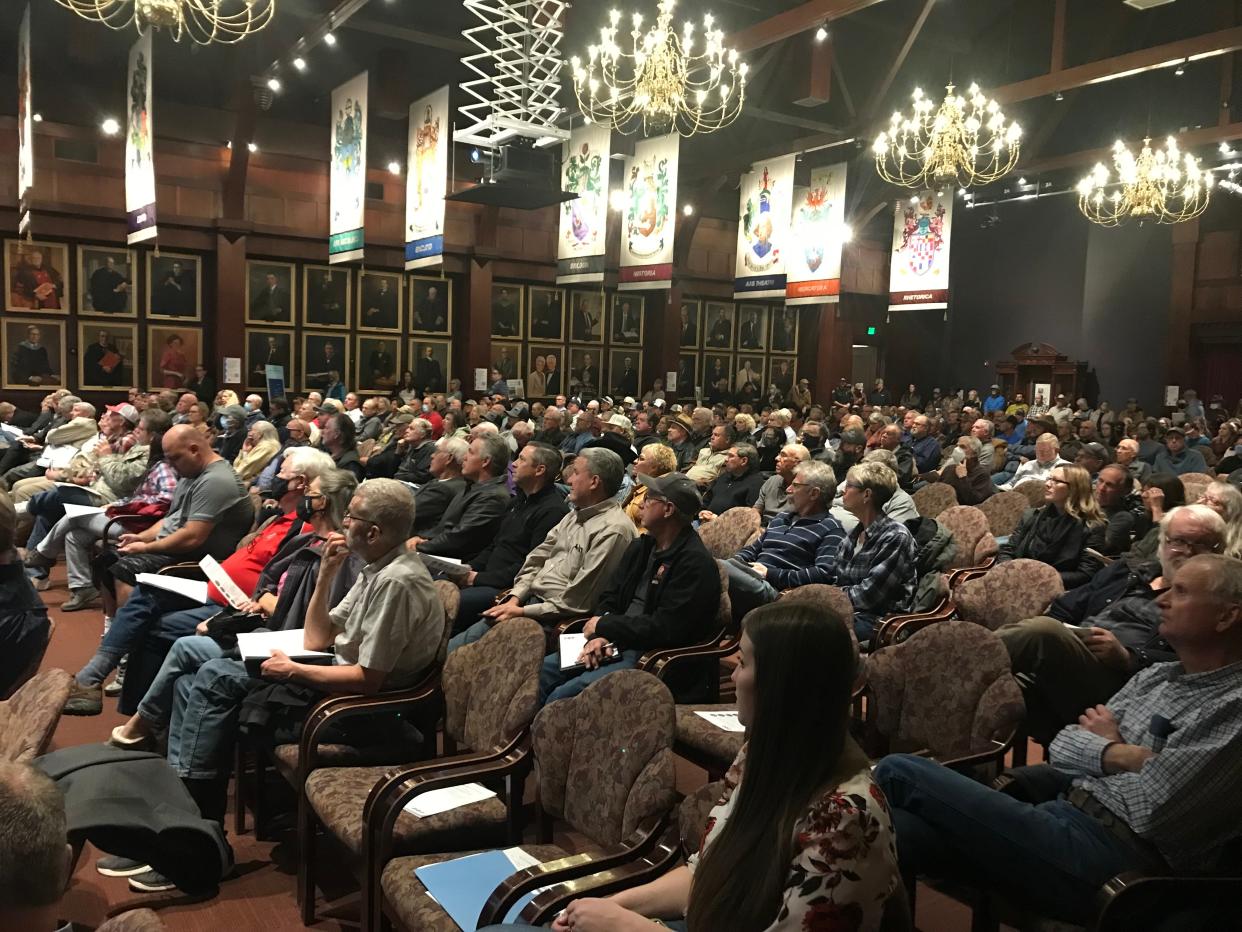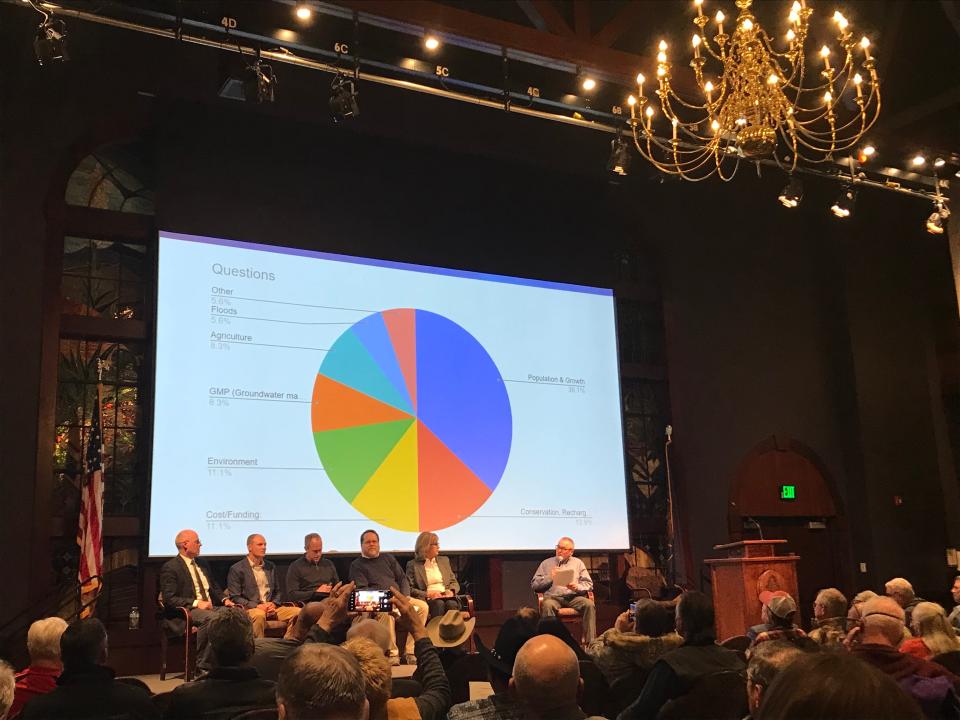Iron County water district addresses concerns over water future, environmental costs

The Central Iron County Water Conservancy District (CICWCD) and other Iron County officials faced a packed room Tuesday night to address rising concerns from the public about the region's water future.
According to the district's breakdown of questions they received in advance of the meeting, 36% of inquiries were related to population and growth, 14% to conservation and recharge, 11% to costs and funding, another 11% to the environment, 8% each to groundwater management and agriculture and 5% to flooding.
Despite the region being locked in record-setting drought, Iron County experienced several flooding events this summer when heavy, localized monsoonal rains fell on dry ground faster than drainage systems could absorb them. One flooded 320 homes in Enoch alone. But the valley's water woes extend to other aspects of local life, and interest in solutions to these problems is on the rise.
More: The Water Tap: Thunderstorms and flash floods can't fix Utah's drought
As the meeting began, the Hunter Conference Center Great Hall at Southern Utah University was standing-room-only, with more than 400 in attendance. County locals as well as residents of nearby Beaver and Millard counties who have concerns about how CICWCD water projects might impact their communities filled the seats, while many activists and media stood in the back. Advocacy groups present included The Great Basin Water Network, the Utah Rivers Council, the Iron County Water Conservatives and the Iron County Citizens for Sustainable Water Use.
According to Kyle Roerink of the Great Basin Water Network, the CICWCD held the meeting as a reaction to recent local newspaper ads his group sponsored notifying the Cedar City community about possible impending costs and environmental impacts of the district's proposed $260 million Pine Valley Water Supply (PVWS) project. The project is currently stalled in the federal environmental review process, but if approved would aim to transport up to 15,000 acre-feet of water annually, about 4.9 billion gallons, to Cedar City from a remote valley in western Beaver County through a 66-mile buried pipeline.
The project is not the CICWCD's only plan of attack for water security concerns. But a handout they shared at the meeting made the district's view clear that "conservation and reuse are not enough to fix our water resource issues. We must diversify our water resources and extend our reach for water."
Through Utah's first-in-time, first-in-right water policy, which allows water rights to be sold to whoever applies for them first rather than to users adjacent to the source, the CICWCD obtained legal rights to the Pine Valley water in 2014. It hopes to have the pipeline flowing by 2030. But the plans have been met with trepidation from Iron County locals and neighbors alike about how the groundwater pumping may impact local environments, sensitive species and springs that sustain family ranching operations, as well as whether or not the water export counts as stealing from a "sister county's" opportunity to grow.

A year ago, Roerink spearheaded a petition opposing the PVWS project that quickly accumulated 30,000 signatures and now, a year later, stands at more than 125,000 signatures on change.org. The petition argues that the proposed groundwater pumping will have far-reaching negative effects on the environment.
More: Petition to stop Cedar Valley's West Desert water pipeline draws support and ire
At the time, Paul Monroe, General Manager of the CICWCD, responded to this petition by stating that "our adaptive approach demonstrates that there will not be impacts to Nevada, the Great Basin National Park or the Great Salt Lake."
A year later, his position has not changed. Much of Monroe's presentation on Tuesday, the central event of the evening, centered around how the PVWS project is Iron County's best option to deal with the water dilemma, which has already resulted in the state engineer imposing a groundwater management plan on the valley that lays out a schedule of cuts to local water rights.
More: The Water Tap: Cedar Valley to adopt new groundwater management plan that includes cuts
In making this argument, Monroe discussed Iron County's rapid population growth, simultaneous extreme drought and warming temperatures due to climate change and the resulting problem of the valley's underground aquifer, its main water source, being drained faster than it can be replenished. This unsustainable withdrawal rate has caused the ground surface to collapse in several places, sounding the death knell for at least one development project.
Monroe, along with the four other members of a panel presentation that followed his address, see infrastructure projects like the Pine Valley Water Supply pipeline as the obligation of current residents to future generations.
"We all drink from wells we didn't dig," Monroe said.
Others in attendance, however, maintain that the environmental risks — not to mention the financial costs of the project, which advocacy groups claim will be much higher than the $46.54 the district presented as the expected monthly increase to household water bills by 2030 — are just not acceptable tradeoffs.
"I think the effect on the wider region is much more than what seems to be implied here," said Laura Cotts, a member of Iron County Citizens for Sustainable Water Use, in reaction to the information presented at the meeting. "I think it is a regional problem. And we need to pay attention to that. Because we have a responsibility, not just to ourselves."
Joan Meiners is the Environment Reporter for The Spectrum & Daily News through the Report for America initiative by The Ground Truth Project. Support her work by donating to these non-profit programs today. Follow Joan on Twitter at @beecycles or email her at jmeiners@thespectrum.com.
This article originally appeared on St. George Spectrum & Daily News: Debate rises over proposed water pipeline for Cedar City, Iron County

